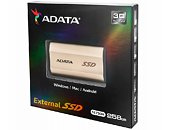Thursday, July 13th 2017

ADATA Releases the SE730H External SSD with 10 Gbps USB 3.1 Type-C
ADATA Technology, a leading manufacturer of high performance DRAM modules, NAND Flash products, and mobile accessories today launched the SE730H external solid state drive, an update of the best-selling SE730. The SE730H performs at 500 MB/s read and write, and moves to 3D TLC NAND for increased durability and longevity, while remaining one of the most compact external SSDs worldwide.
It has a reversible USB-C connector for greater convenience, and a stylish metallic design. Data transfers use USB 3.1 Gen 2 (up to 10Gbps). Importantly, the SE730H meets IEC IP68 dust and water proof requirements, as well as military-grade shock mitigation standards. Available in 256GB and 512GB, the SE730H is Windows, Mac OS, and Android compatible for seamless cross-platform usage.Super compact with the benefit of 3D NAND
While previous generation SE730 drives were only available in 250GB, the shift to high quality 3D TLC NAND has allowed ADATA to offer the SE730H in up to 512GB. At the same time, the SE730H maintains is compact footprint as the smallest device in its class (external USB-C 3D NAND SSD). It weighs a mere 33g, and users can choose from gold or red metallic color schemes. With 3D TLC NAND, the SE730H delivers more than just bigger capacity: 3D NAND is also around 25% longer-lasting than 2D NAND, and more reliable for the life of the product while consuming less power, a plus for paired device batteries. In terms of performance, the SE730H reaches 500MB/s read and write, or about five times the speed of external mechanical drives.
Convenient and fast USB-C
With reversible USB-C, connecting devices no longer involves checking plug alignment, as there is no up or down. The SE730H connects to USB-C capable devices the first time, every time. It does so with support for USB 3.1 Gen 2, or real USB 3.1 - which allows for up to 10Gbps as opposed to 5Gbps on USB 3.0/USB 3.1 Gen 1. At those speeds, a 5GB file takes just 16 seconds to move, and a big AAA game requires less than a minute. ADATA includes a USB-C to USB-C cable in the box.
Small but mighty tough on multiple platforms
The SE730H passes IEC IP68 tests, meaning complete dust-tight protection and water proofing to 60 minutes in 1.5 meters of water. It also meets MIL-STD-810 516.6 impact and shock resistance requirements, resulting in a product that can easily handle active lifestyles to keep stored data safe. The SE730H works in plug n play with no drivers needed on Windows, Mac OS, and Android, allowing for easy content sharing and portability across devices, from smartphones to desktops.
It has a reversible USB-C connector for greater convenience, and a stylish metallic design. Data transfers use USB 3.1 Gen 2 (up to 10Gbps). Importantly, the SE730H meets IEC IP68 dust and water proof requirements, as well as military-grade shock mitigation standards. Available in 256GB and 512GB, the SE730H is Windows, Mac OS, and Android compatible for seamless cross-platform usage.Super compact with the benefit of 3D NAND
While previous generation SE730 drives were only available in 250GB, the shift to high quality 3D TLC NAND has allowed ADATA to offer the SE730H in up to 512GB. At the same time, the SE730H maintains is compact footprint as the smallest device in its class (external USB-C 3D NAND SSD). It weighs a mere 33g, and users can choose from gold or red metallic color schemes. With 3D TLC NAND, the SE730H delivers more than just bigger capacity: 3D NAND is also around 25% longer-lasting than 2D NAND, and more reliable for the life of the product while consuming less power, a plus for paired device batteries. In terms of performance, the SE730H reaches 500MB/s read and write, or about five times the speed of external mechanical drives.
Convenient and fast USB-C
With reversible USB-C, connecting devices no longer involves checking plug alignment, as there is no up or down. The SE730H connects to USB-C capable devices the first time, every time. It does so with support for USB 3.1 Gen 2, or real USB 3.1 - which allows for up to 10Gbps as opposed to 5Gbps on USB 3.0/USB 3.1 Gen 1. At those speeds, a 5GB file takes just 16 seconds to move, and a big AAA game requires less than a minute. ADATA includes a USB-C to USB-C cable in the box.
Small but mighty tough on multiple platforms
The SE730H passes IEC IP68 tests, meaning complete dust-tight protection and water proofing to 60 minutes in 1.5 meters of water. It also meets MIL-STD-810 516.6 impact and shock resistance requirements, resulting in a product that can easily handle active lifestyles to keep stored data safe. The SE730H works in plug n play with no drivers needed on Windows, Mac OS, and Android, allowing for easy content sharing and portability across devices, from smartphones to desktops.



14 Comments on ADATA Releases the SE730H External SSD with 10 Gbps USB 3.1 Type-C
Sure, this drive won't use USB 3.1 to it fullest, but it does support the upcoming USB connector and not the outgoing version.
I think the standard Flash sticks (the big size ones I mean) will be going into a slow death since they will never be able to compete with an external SSD.
Love Aquinas' analogy with PCIe bandwidth. :)